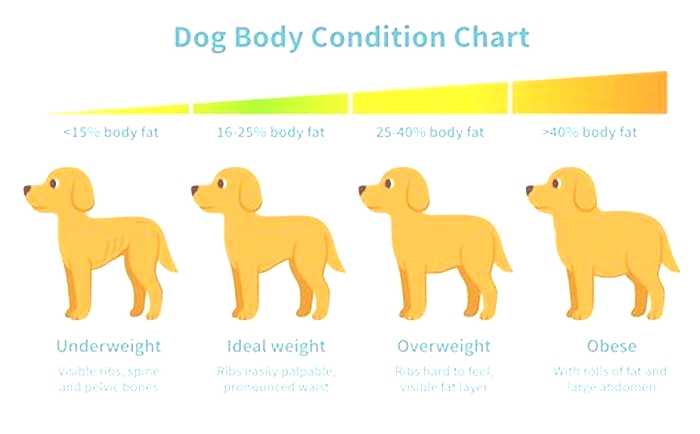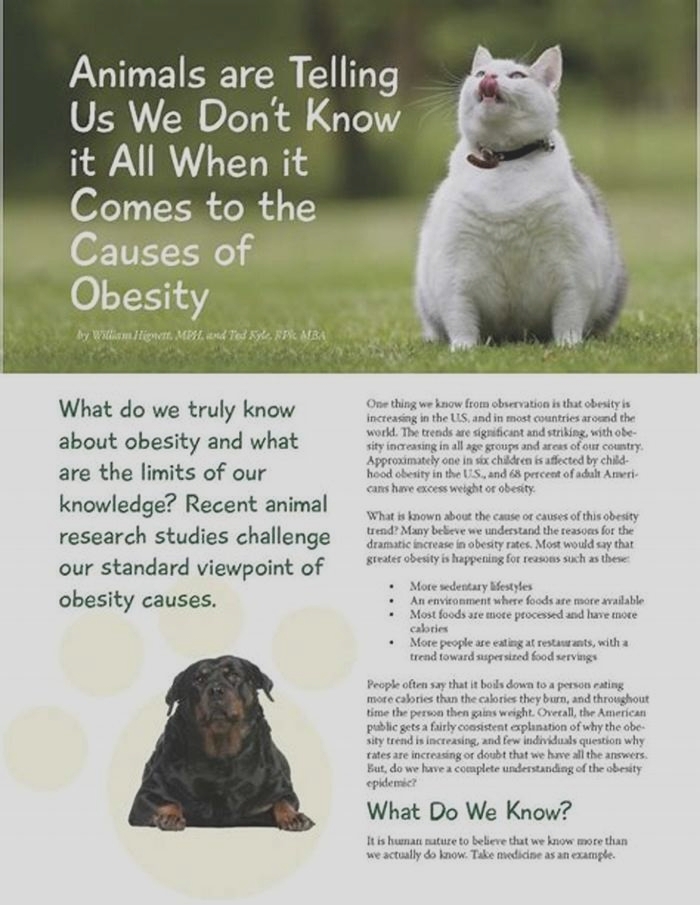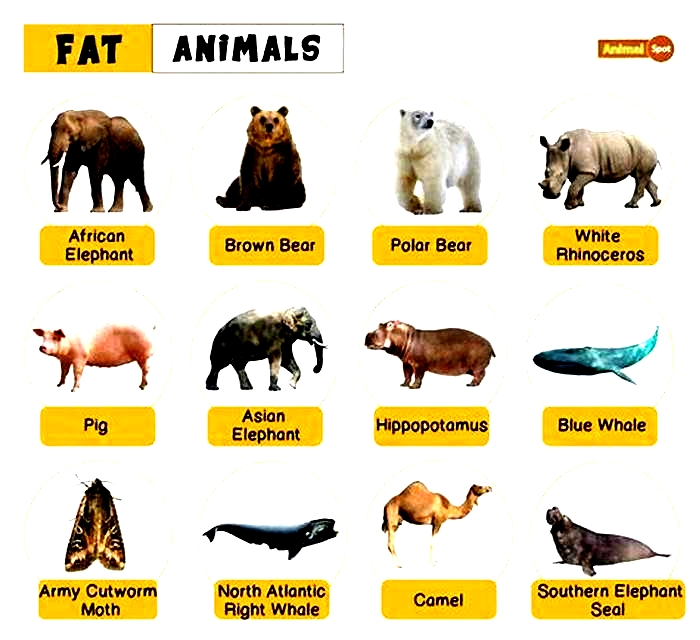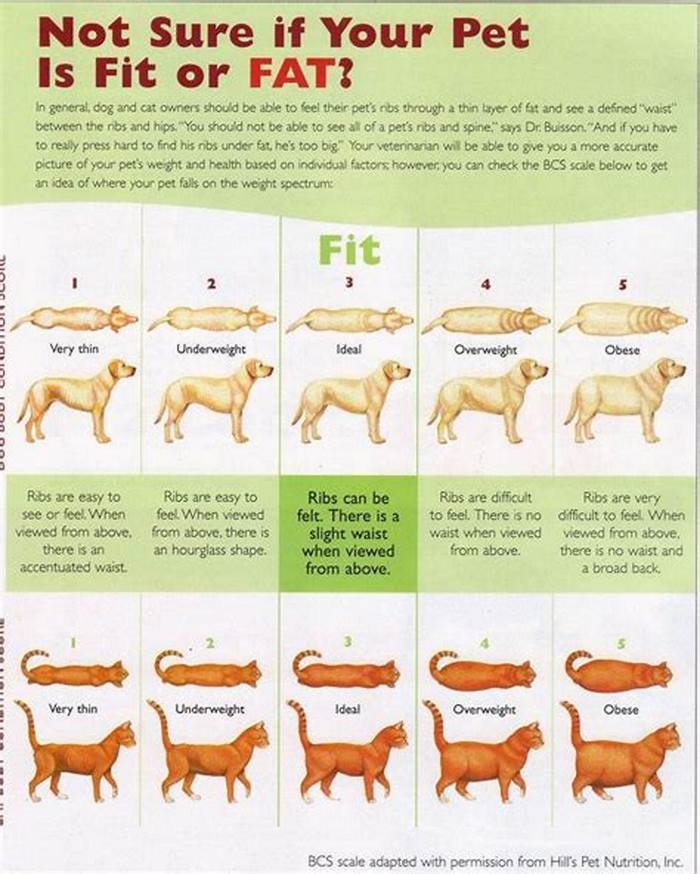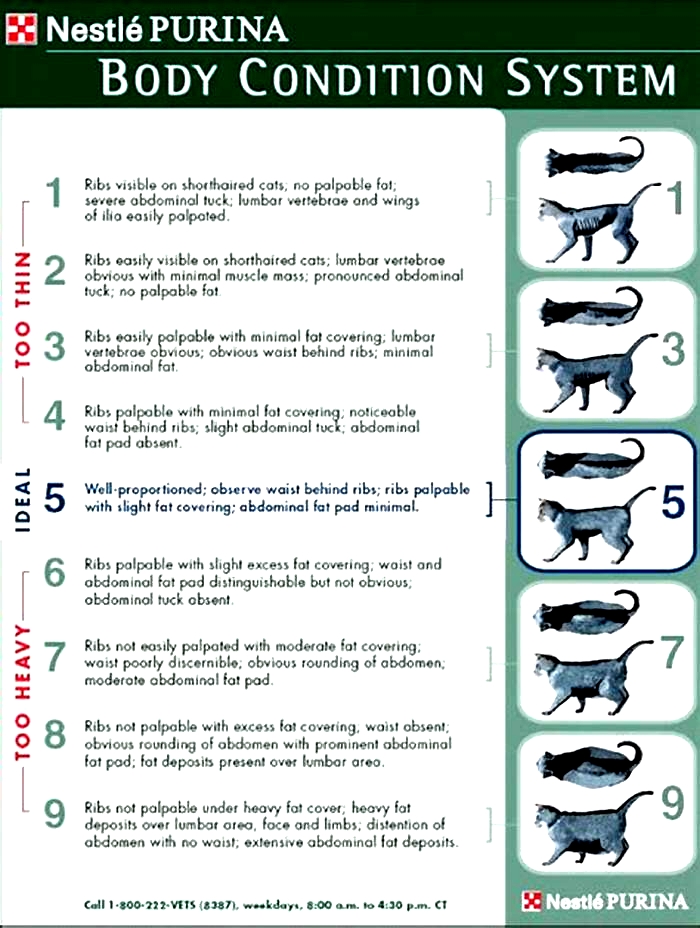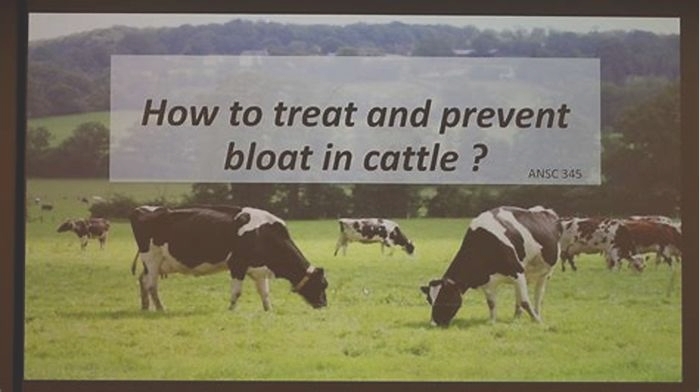Are lab animals getting fatter

Chunky Monkey: Lab Animals Are Getting Fatter and Scientists Dont Know Why
Lots of things could explain why there are so many overweight Americansfast-food consumption, not enough exercise, our national zealotry for bacon.
Mmm, bacon.
But I digress.
None of those unhealthy habits can be blamed as the answer to one question: Why are our lab animals getting fat?
Unless lab rats are escaping captivity to feast on Twinkies (which, I admit, I kind of hope they are), it doesnt make sense that caged animals are getting fatter.
But unlike street animals that may be feasting on trash, lab animals are gaining weight, according to Aeon Magazine.
The scales are showing higher average weight over the past decade for laboratory macaques, chimpanzees, vervet monkeys, mice, dogs, cats and rats.
For some reason, chimps are doing worst of all: Their average body weight has risen 35 percent per decade. Its unclear whether animals used to get more exercise or conditions have affected their mood in a way that causes obesity.
Researchers believe hidden global factors might be contributing to a mysterious, widely shared cause that is making humans and other animals fatter.
That mystery cause could be just about anything as obesity researchers analyze sleeplessness, stress, intake of bisphenol-A (BPA) and other prevalent chemicals, viruses, gut bacteria or even eating at night, when our ancient ancestors were sleepingthe list goes on and on.
Scientists are also beginning to consider roads less traveled in obesity research, such as the creation of thermoneutral zones, also known as air-conditioned and heated places.
When people are in the outdoors and exposed to the elements, heat makes them sweat, cold makes them shiver and the body has to expend energy to maintain a normal internal temperature.
Temperatures above and below the neutral zone (found in climate-controlled environments) have been shown to cause both humans and animals to burn fat, and hotter conditions also have an indirect effect: they make people eat less, Aeon reported.
Then theres the theory of infectobesity, which believes obesity may be infectious, like the flu. A virus known for causing eye and respiratory infections in people could also be infecting them with obesity. The virus, called Ad-36, has caused weight gain in chickens, rats, mice and monkeys. It hasnt been tested on humans, but testing found that obese people are much more likely to have the antibody to the virus in their bodies.
Whatever the case may be, scientists believe attributing obesity to personal responsibility is simplistic.
Related stories on TakePart:
5 Obesity Myths You Probably Believe
A Surprising Dip in Childhood Obesity Rates
BPA and Childhood Obesity Linked, But Questions Remain
Original article from TakePart
The obesity trend isnt only affecting humans chimps, pets, and lab rats are getting fatter too
We spend a lot of time talking about how fat one type of animal has gotten in recent years: humans. But what about all the other animals living near people have they gained weight, too?
That's the question a group of American researchers asked in a fascinating, first-of-its-kind study I recently discovered in the Proceedings of the Royal Society B.
The researchers, led byDavid Allison of the University of Alabama, looked at more than 20,000 animals from eight speciesthat live near or with humans in industrialized places. This included several species of monkeys, chimpanzees, wild rats, lab mice and rats, and domestic cats and dogs.
:no_upscale()/cdn.vox-cdn.com/uploads/chorus_asset/file/3984302/graph.jpg)
Body weight changes per decade.
(Royal Society Publishing)
In every population, the trend was clear: The animals gained weight. In 11 out of 24 populations, the change was statistically significant, meaning it was big enough to be more than pure chance."Viewed as an ensemble," the researchers wrote, "the positive direction for both weight gain and for the odds of obesity is overwhelmingly statistically significant."
Maybe domestic pets and feral rats fattened up because the availability of food has increased over the years. But how does that explain why lab animals in controlled environments got heavier, too?
The researchers suggest the trend could be driven by "any number of environmental cues such as stressors, resource availability, release from predation or climate change."Perhaps it's the endocrine-disrupting chemicals that are now ubiquitous in commercial products. Or there could be a viral cause of obesity. (Other research has already explored this theory.)
I emailed David Allison, the lead author of the study, to see if his team has done any further research on the changing rates of obesity in populations of animals since this 2011 study. They haven't, and I could not find other follow-up. To complicate matters, it turns out Allison has faced conflict-of-interest allegations for having received funding from the food industry. So it's possible the study is biased toward attempting to shift the blame for obesity on environmental factors instead of commercial ones.
For now, this is just one observational study that raises more questions than it answers. This is a shame. Even if environmental cues can't explain everything about obesity, it's clearly a terribly complex problem, and studying other species could tell us something about the less obvious contributors to the human epidemic.
Yes, I'll give $5/month
Yes, I'll give $5/month
We accept credit card, Apple Pay, and Google Pay. You can also contribute via

It's Not Just Us: Even American Animals Are Getting Fatter
 .
.Everyone knows Americans are fat and getting fatter, and everyone thinks they know why: more eating and less moving.
But the "big two" factors may not be the whole story. Consider this: Animals have been getting fatter too. The National Pet Obesity Survey recently reported that more than 50 percent of cats and dogsthat's more than 80 million petsare overweight or obese. Pets have gotten so plump that there's now a National Pet Obesity Awareness Day. (It was Wednesday.) Lap dogs and comatose cats aren't alone in the fat animal kingdom. Animals in strictly controlled research laboratories that have enforced the same diet and lifestyle for decades are also ballooning.
In 2010, an international team of scientists published findings that two dozen animal populationsall cared for by or living near humanshad been rapidly fattening in recent decades. "Canaries in the Coal Mine," they titled the paper, and the "canaries" most closely genetically related to humanschimpsshowed the most troubling trend. Between 1985 and 2005, the male and female chimps studied experienced 33.2 and 37.2 percent weight gains, respectively. Their odds of obesity increased more than 10-fold.
To be sure, some of the chimp obesity crisis may be caused by the big two. According to Joseph Kemnitz, director of the Wisconsin National Primate Research Center, animal welfare laws passed in recent decades have led caretakers to strive to make animals happier, often employing a method known to any parent of a toddler: plying them with sugary food. "All animals love to eat, and you can make them happy by giving them food," Kemnitz said. "We have to be careful how much of that kind of enrichment we give them. They might be happier, but not healthier."
And because they don't have to forage for the food, non-human primates get less exercise. Orangutans, who Kemnitz says are rather indolent even in their native habitats in Borneo and Sumatra, have in captivity developed the physique of spreading batter.
Still, in "Canaries in the Coal Mine," the scientists write that, more recently, the chimps studied were "living in highly controlled environments with nearly constant living conditions and diets," so their continued fattening in stable circumstances was a surprise. The same goes for lab rats, which have been living and eating the same way for thirty years.
The potential causes of animal obesity are legion: ranging from increased rates of certain infections to stress from captivity. Antibiotics might increase obesity by killing off beneficial bacteria. "Some bacteria in our intestines are associated with weight gain," Kemnitz said. "Others might provide a protective effect."
But feral rats studied around Baltimore have gotten fatter, and they don't suffer the stress of captivity, nor have they received antibiotics. Increasingly, scientists are turning their attention toward factors that humans and the wild and captive animals that live around them have in common: air, soil, and water, and the hormone-altering chemicals that pollute them.
Hormones are the body's chemical messengers, released by a particular gland or organ but capable of affecting cells all over the body. While hormones such as testosterone and estrogen help make men masculine and women feminine, they and other hormones are involved in a vast array of functions. Altering or impeding hormones can cause systemic effects, such as weight gain.
More than a decade ago, Paula Baille-Hamilton, a visiting fellow at Stirling University in Scotland who studies toxicology and human metabolism, started perusing scientific literature for chemicals that might promote obesity. She turned up so many papers containing evidence of chemical-induced obesity in animals (often, she says, passed off by study authors as a fluke in their work) that it took her three years to organize evidence for the aptly titled 2002 review paper: "Chemical Toxins: A Hypothesis to Explain the Global Obesity Epidemic." "I found evidence of chemicals that affect every aspect of our metabolism," Baille-Hamilton said. Carbamates, which are used in insecticides and fungicides, can suppress the level of physical activity in mice. Phthalates are used to give flexibility to plastics and are found in a wide array of scented products, from perfume to shampoo. In people, they alter metabolism and have been found in higher concentrations in heavier men and women.
In men, phthalates interfere with the normal action of testosterone, an important hormone for maintaining healthy body composition. Phthalate exposure in males has been associated with a suite of traits symptomatic of low testosterone, from lower sperm count to greater heft. (Interference with testosterone may also explain why baby boys of mothers with higher phthalate levels have shorter anogenital distances, that is, the distance between the rectum and the scrotum. Call it what you want, fellas, but if you have a ruler handy and find that your AGD is shorter than two inches, you probably have a smaller penis volume and a markedly higher risk of infertility.)
Baille-Hamilton's work highlights evidence that weight gain can be influenced by endocrine disruptors, chemicals that mimic and can interfere with the natural hormone system.
A variety of flame retardants have been implicated in endocrine disruption, and one chemical originally developed as a flame retardantbrominated vegetable oil, or BVOis banned in Europe and Japan but is prevalent in citrusy soft drinks in the U.S. Earlier this year, Gatorade ditched BVO, but it's still in Mountain Dew and other drinks made by Gatorade's parent company, PepsiCo. (Many doctors would argue that for weight gain, the sugar in those drinks is the primary concern.) PepsiCo did not respond to a request for comment, but shortly after the Gatorade decision was made a company spokeswoman said it was because "some consumers have a negative perception of BVO in Gatorade."
And then there are the newly found zombie chemicals, which share a nasty habitrising from the dead at nightwith their eponymous horror flick villains. The anabolic steroid trenbolone acetate is used as a growth promoter in cattle in the U.S., and its endocrine disrupting metaboliteswhich wind up in agricultural run-off waterwere thought to degrade quickly upon exposure to sunlight. Until last month, when researchers published results in Science showing that the metabolites reconstitute themselves in the dark.
Says Emily Dhurandhar, an obesity researcher at the University of Alabama-Birmingham: "Obesity really is more complex than couch potatoes and gluttons."
Photo by Jagodka via Shutterstock.
This article is from the archive of our partner The Wire.
On not getting contaminated by the wrong obesity ideas
A Chemical Hunger(a), a series by the authors of the blogSlime Mold Time Mold (SMTM), argues that the obesity epidemic is entirely caused (a) by environmental contaminants.
Inmy last post, I investigated SMTMs main suspect (lithium).[1]This post collects other observations I have made aboutSMTMs work, not narrowly related to lithium, but rather focused on the broader thesis of their blog post series.
I think that the environmental contamination hypothesis of the obesity epidemic is a priori plausible. After all, we know that chemicals can affect humans, and our exposure to chemicals has plausibly changed a lot over time. However, I found that several of what seem to be SMTMs strongest arguments in favor of the contamination theory turned out to be dubious, and that nearly all of the interesting things I thought Id learned from their blog posts turned out to actually be wrong. Ill explain that in this post.
Summary of main points
Its not clear that lab animals *or* wild animals have been getting fatter
When I was readingA Chemical Hunger, the argument I found most compelling was the following (fromPart I: Mysteries (a)):
Humans arent the only ones who are growing more obese lab animals and even wild animals are becoming more obese as well. Primates and rodents living in research colonies, feral rodents living in our cities, and domestic pets like dogs and cats are all steadily getting fatter and fatter. This cant be attributed to changes in what they eat, because lab animals live in contained environments with highly controlled diets. Theyre being fed the same foods as always, but for some reason, theyre getting fatter.
The interesting claims here are that lab animals on controlled diets and wild animals have allegedly gotten fatter. So I decided to investigate those claims.
The hyperlink in that quote leads you to a 2010 study by Klimentidis et al. which, as far as I can tell, is the only study to have investigated the issue. Googling are lab animals getting fatteryields a bunch of articles that all seem to cite that one paper as their source (except for a few results that dont seem related to the question). I combed through the papers179 Google Scholar citations and could not find a replication.
(By the way, contrary to what SMTMs writing implies, this paper did not analyze the weight of wild animals, as well discuss below).
Since Klimentidis et al. (2010)s results have apparently not been replicated, I decided to attempt to replicate them myself.
Lab mice
I first thought this would be extremely hard or impossible to do, since there are way too many studies on mice. How was I supposed to find an unbiased, representative sample of mouse body weights over time?
Fortunately, however, some Google searches eventually led me toThe Jackson Laboratorys Mouse Phenome Database (a), which has a ton of phenotypic data of JAX mice, which their websitesays (a) are the the best characterized and most widely used mice available. Importantly, the database includes body weight data from as far back as 2000, and you can filter the data for mice strain, so it seems like a good place to figure out whether genetically homogeneous lab mice have indeed grown fatter in tandem with humans.
Wikipediasays (a) that C57BL/6 mice are [b]y far the most popular laboratory rodent. So I thought that a good way of attempting to replicate Klimentidis et al.s work would be to investigate whether C57BL/6J mice (that is (a), C57BL/6 mice from the Jackson Laboratory, the most common substrain of C57BL/6 mice[2]) have increased in body weight over time.
My analysis of the data is inthis Google Colab notebook. Ifound positive correlations between year of measurement and average body weight of C57BL/6J mouse samples (r=0.17 for females and 0.12 for males), but this is before adjusting for age.
C57BL/6J mice grow roughly logarithmically with age; the correlation between log(age) and body weight is 0.74 for female mice and 0.70 for male mice in my sample. This is what their growth curveslook like (a):
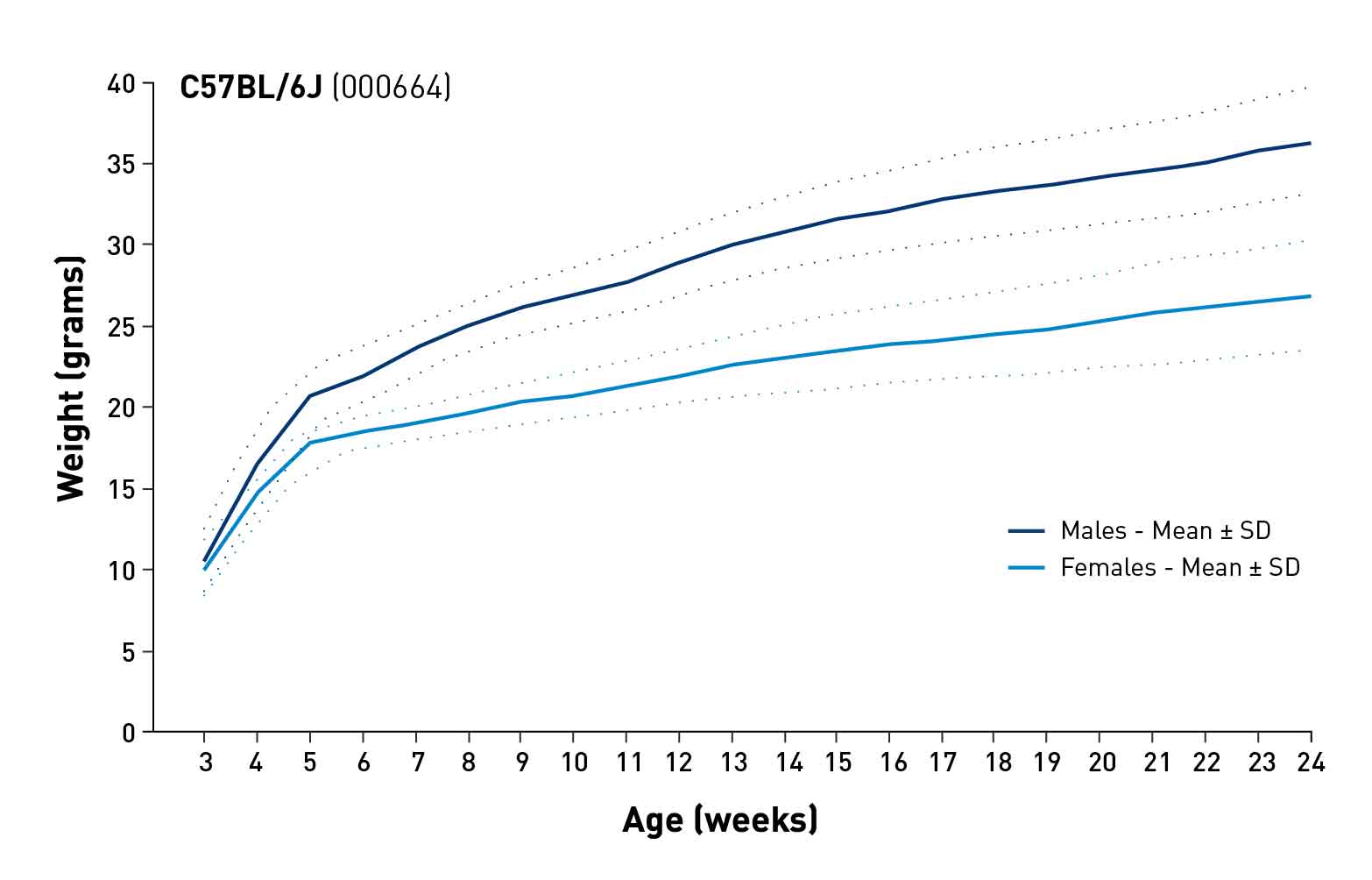
So I decided tocontrol for log(age). After doing so, the correlationsare -0.1 for both sexes. Multiple regressionindicates that the average age-adjusted weight of female C57BL/6J mice has been decreasing by 0.06 grams per year, and that of male mice by 0.08 grams per year, which was not significantly different from 0.
The standard deviation of body weight has increased a bit for male mice (r = 0.09) but decreased for female mice (r = -0.18). Controlling for log(age), those correlationsare 0.05 and -0.29, respectively. None of these were significant either. This trend towards a decrease in the SD of body weight among female mice, as well as the trend towards a decrease in average age-adjusted body weight among both sexes, is the opposite of what has happened among humans in the same timeframe.
My findings are in stark contrast withKlimentidis et al. (2010), which find that
Among mice in control groups in the National Toxicology Programme (NTP), there was a 11.8 per cent increase in body weight per decade from 1982 to 2003 in females coupled with a nearly twofold increase in the odds of obesity. In males there was a 10.5 per cent increase per decade.
Even more impressively, this paper looked at 24 different datasets of animals living among humans (most though not all of which seemed to have been on controlled diets) and found that age-adjusted body weights increased with time inall of them. The paper helpfully reminds us that the probability of all of those trends being in the same direction by chance is1.2107.
I... dont know how to explain the difference. If their datasets are representative of the underlying distribution of animals living among humans, it should have been extremely unlikely for me to have found this dataset with an age-adjusted (non-significant) decrease in body weight.
Their paper did use a different statistical methodology from mine, but I honestly dont fully understand it (its a lot more complicated than a simple correlation coefficient or regression model) so I wouldnt be able to make an educated guess on how much thats related.
Perhaps the C57BL/6J mice in my dataset have been fed progressively lower-calorie diets because researchers want them to maintain historically consistent body weights? But then why doesnt that apply to any of the lab animal datasets in Klimentidis et al. (2010)?
Perhaps C57BL/6J mice are immune to whatever contaminant is causing obesity? But that would be weird, because Klimentidis et al. (2010) find secular increases in body weight in animals from a wide variety of different species.
Perhaps I cherry-picked my dataset? But recall that my data is from the most common substrain (C57BL/6J) of the most common strain (C57BL/6) of lab mice in the research world, and, as far as I can tell, I included all of the body weight data that the Mouse Phenome Database has on this substrain from mice undergoing no interventions. Also, I checked the next five most common strains in the dataset and replicated my findings.
So, uh, I dont know.
I could have done something wrong in my analysis. I am not sure that my math is perfect. So its important to take that into account.
One consideration that complicates the interpretation of Klimentidis et al. (2010)s findings is the fact that David B. Allison (who Naturerefers to as the lead author of the study) has apparently been involved in controversies regarding his conflict of interest with the processed food and restaurant industries.[3]
Given that, and given that I could not replicate the findings with data from the Jackson Laboratorys Mouse Phenome Database, I think it would be nice to have at least one independent replication of this study before confidently asserting (as the SMTM authors do) that lab mice have been getting fatter in tandem with humans.
Wild animals
The SMTM authors have claimedseveral times in their blog (a) that wild animals have been getting more obese:
FromPart I: Mysteries(a):
even wild animals are becoming more obese as well
FromPart III: Environmental Contaminants (a):
Lab animals and wild animals are becoming more obese because they are exposed to the same environmental contaminants that we are.
FromPart IX: Anorexia in Animals (a):
even wild animals have gotten more obese over the past several decades
FromInterlude E: Bad Seeds (a):
Seed oils have a hard time accounting forpatterns like obesity being related to altitude, and wild animals also becoming obese.
The only source they mention intheir blog for that claim is the study above by Klimentidis et al. However, that study only examined animal populations living in close proximity to humans; the wildest animal population they include is Norway ratsliving in human towns (and thus likely eating human food), which isprobably not what people have in mind (a) when they think of wild animals. None of the animals in the study were in the wilderness or had wild diets.
When Divia Carolinepointed that out to them on Twitter (a), theybrought up studies (a) showing that populations of white-tailed deer experiencing increasing predation from humans have been getting heavier:

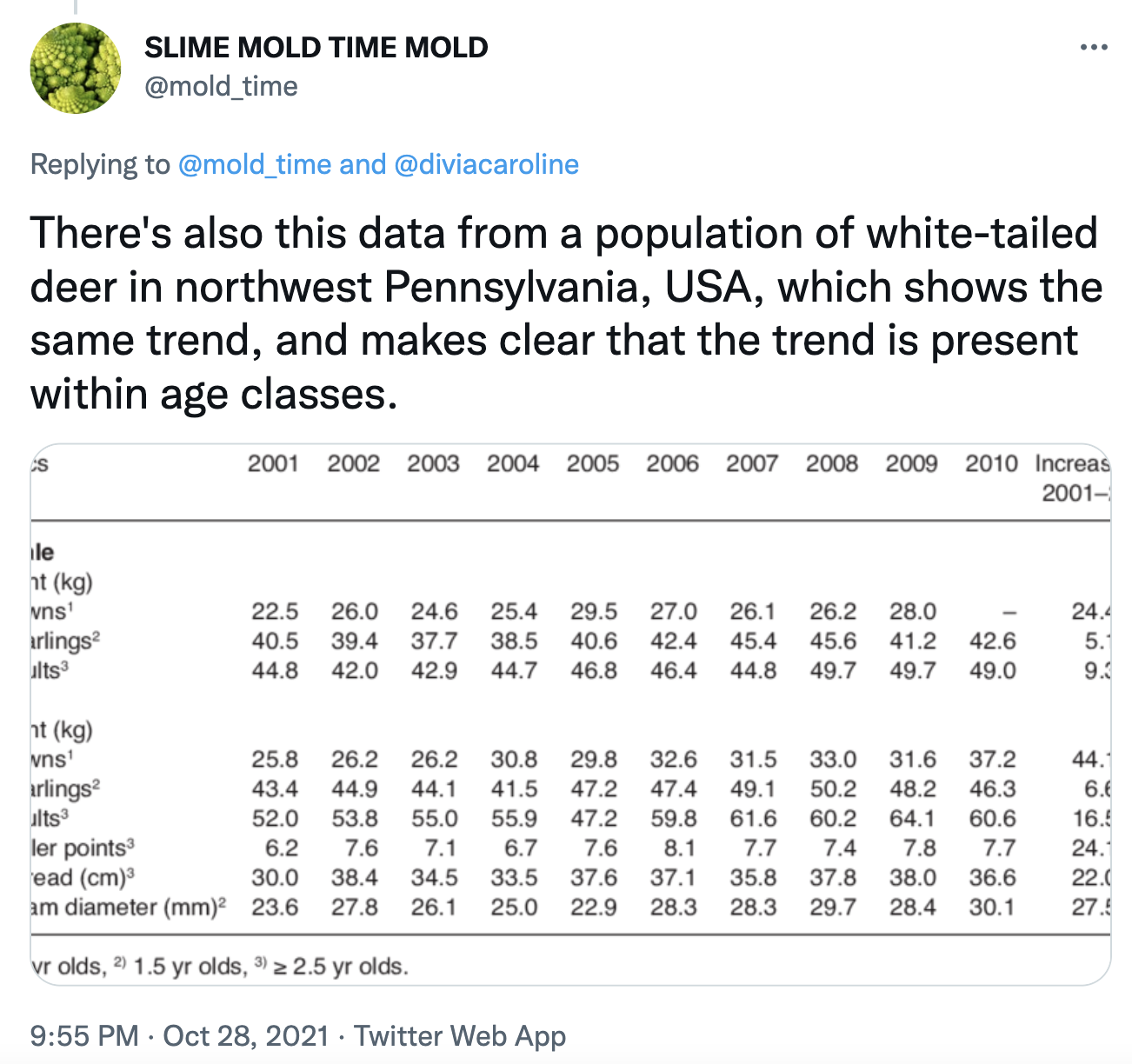 However, this is really not great evidence that wild animals are becoming more obese. Both of the studies they mention in those tweets Wolverton et al. (2008) andStout et al. (2013) examined populations of white-tailed deerunder increasing predation from humans. Predation decreases their population density, which increases the amount of energy available for each individual deer in their habitat. Both papers explicitly talk about the increase in average body weight as an expected, direct consequence of the increase in hunting. Further supporting this explanation is the fact that modern-day deer populations that arent hunted by humans have much lower average weights than those that are (p < 0.0001) according toWolverton et al. (2007).
However, this is really not great evidence that wild animals are becoming more obese. Both of the studies they mention in those tweets Wolverton et al. (2008) andStout et al. (2013) examined populations of white-tailed deerunder increasing predation from humans. Predation decreases their population density, which increases the amount of energy available for each individual deer in their habitat. Both papers explicitly talk about the increase in average body weight as an expected, direct consequence of the increase in hunting. Further supporting this explanation is the fact that modern-day deer populations that arent hunted by humans have much lower average weights than those that are (p < 0.0001) according toWolverton et al. (2007).
Additionally, these studiesdo not even attempt to measure the body fat of the deer, so its not as if they find that white-tailed deer have been accumulating more adipose tissue over time or anything like that.We dont even know whether the deer equivalent of BMI has increased over time in those populations or not. In fact, given thatWolverton et al. (2008) report an increase in the mean size of the astragalus (a type of ankle bone (a)) in deer populations in which the average weight has increased, these deer may be simply getting taller and gaining a lot of lean mass.
So it seems to me inappropriate to bring up those studies as evidence that wild animals are getting more obese; doing so essentially amounts to taking advantage of the fact that people will often confuse increased body weight with increased adiposity. And it completely ignores the fact that the change in average weight in those populations can be explained by known factors unrelated to the obesity epidemic in humans.
There were meaningful changes in obesity rates before the late 20th century
FromA Chemical Hunger Part I: Mysteries:
Mystery 2: An Abrupt Shift
Another thing that many people are not aware of is just how abrupt this change was. Between 1890 and 1976, people got a little heavier. The average BMI went from about 23 to about 26. This corresponds with rates of obesity going from about 3% to about 10%. The rate of obesity in most developed countries was steady at around 10% until 1980, when it suddenly began to rise.
I think this understates the meaningfulness and extent of the changes in average BMI and obesity rates that occurred before 1980.
In the United States, the obesity rate among adults 20-74 years oldwas already 13.4% in 1960-1962 (a), 18-20 years before 1980. We dont have nationally representative data for the obesity rate in the early 20th or late 19th centuries, but itmight have been as low as ~1.5% oras high as 3%, indicating that the obesity rate in the US increased by a factor of >4x from ~1900 to ~1960.
John Komlos and Marek Brabec haveinvestigated the trajectory of BMI deciles by birth cohort in the United States by using fancy statistical modeling on survey data collected between 1959 and 2006 by the National Center for Health Statistics (NCHS). According to their statistical model, BMI deciles have been increasing fairly smoothly across birth cohorts from 1886 to 1986 (note that the x-axes are each cohortsbirth year, not the year their BMI was measured):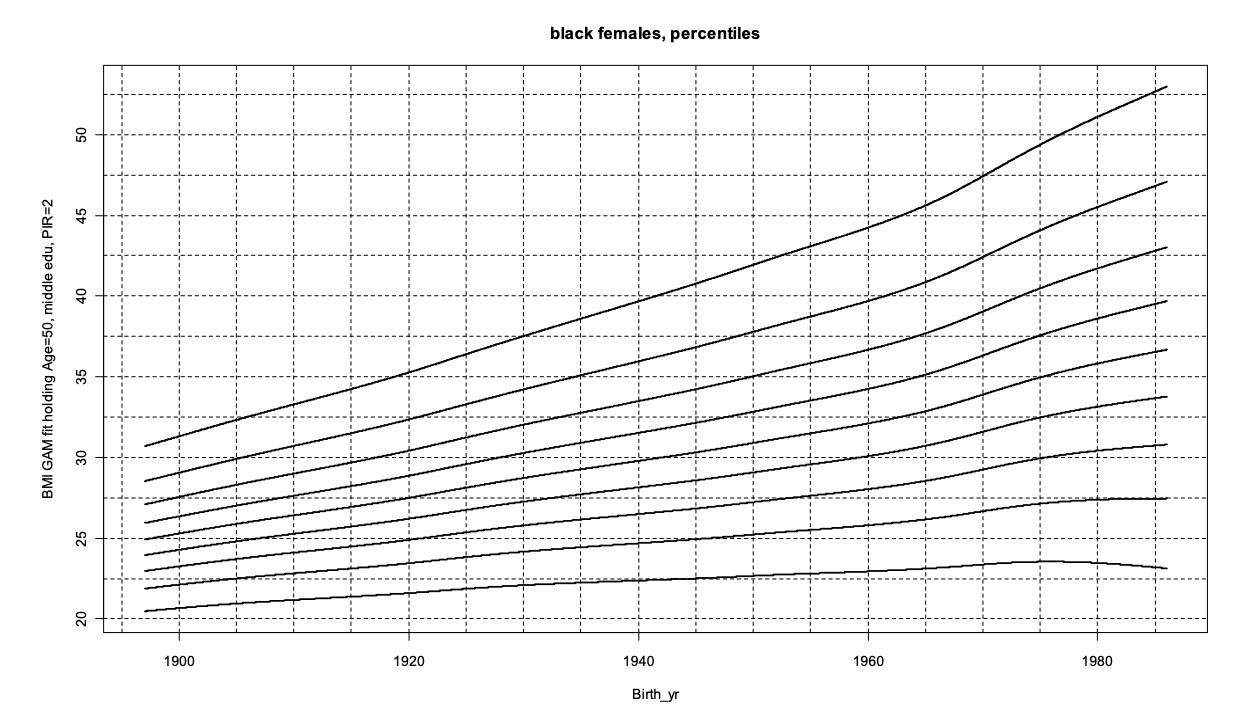

(Those lines are the 10th, 20th, , 90th BMI percentiles. The figures for white females and black males look similar.)
Note that we dont have nationally representative BMI data before 1959 for the US; those lines are estimates based on cohort- and age-associated changes in BMI.
It does look like there has been an acceleration at the later birth cohorts for the few highest BMI percentiles, but a minor acceleration is arguably not the same thing as an abrupt shift. And in fact, the paper points out that for some groups, the rate of change in BMI never actually surpassed its pre-WWII peak.
Another way to demonstrate this: the median weight of a 510 18-year-old white male student at the Citadel Military Academy in Charlestonincreased by 7 kg (or 15.4 lb) from 1888-1927 to 1938-1957. This change wasgreater than the change in median weight of US males of the same age/height/race from the 1980s to the 2000s:

(Again, the x-axis here is each cohorts birth year. These are all 18-year-olds, so you can add 18 to get the measurement year range of each bucket.)
Further evidence of great changes in BMI before 1980 can be found in this Twitter thread (a), which shows, among other things, thatmen at elite colleges (a) (source) andveterans all started getting substantially fatter in the early 20th century.
As you can see, there was a significant slowdown in the increase of BMIs around the middle of the twentieth century. Because of this, looking only at post-war BMI data can give the impression that the rate of change in BMI in the late twentieth century was more unusual than it actually was.
Being underweight is less common than it used to be, not more
The SMTM authors havemade (a) the following claim:
In humans, the obesity epidemic has been matched by an increase in the variance of BMI, which means more people who are overweight AND more people who are underweight
They say that this is evidence of the contamination theory, claiming (a) that [o]ne obvious prediction of the theory that obesity is caused by a contaminant in our environment is that we should also expect to see paradoxical reactions to that contaminant" i.e. in this case, that contaminants that cause most people to gain weight should also cause some people to lose weight.
However, as you can easily figure outby Googling, the prevalence of underweight has been decreasing over time, not increasing, as they claimed.This article in The Lancet (which the SMTM authors have cited once but dont seem to have read[4]) says that:
[From 1975 to 2014], age-standardised global prevalence of underweight decreased from 138% (105174) to 88% (74103) in men and from 146% (116179) to 97% (83111) in women.
Figure 6 from the article shows the trends in age-standardized prevalence of BMI categories by region, in women (Figure 5, which shows the same thing for men, looks similar):
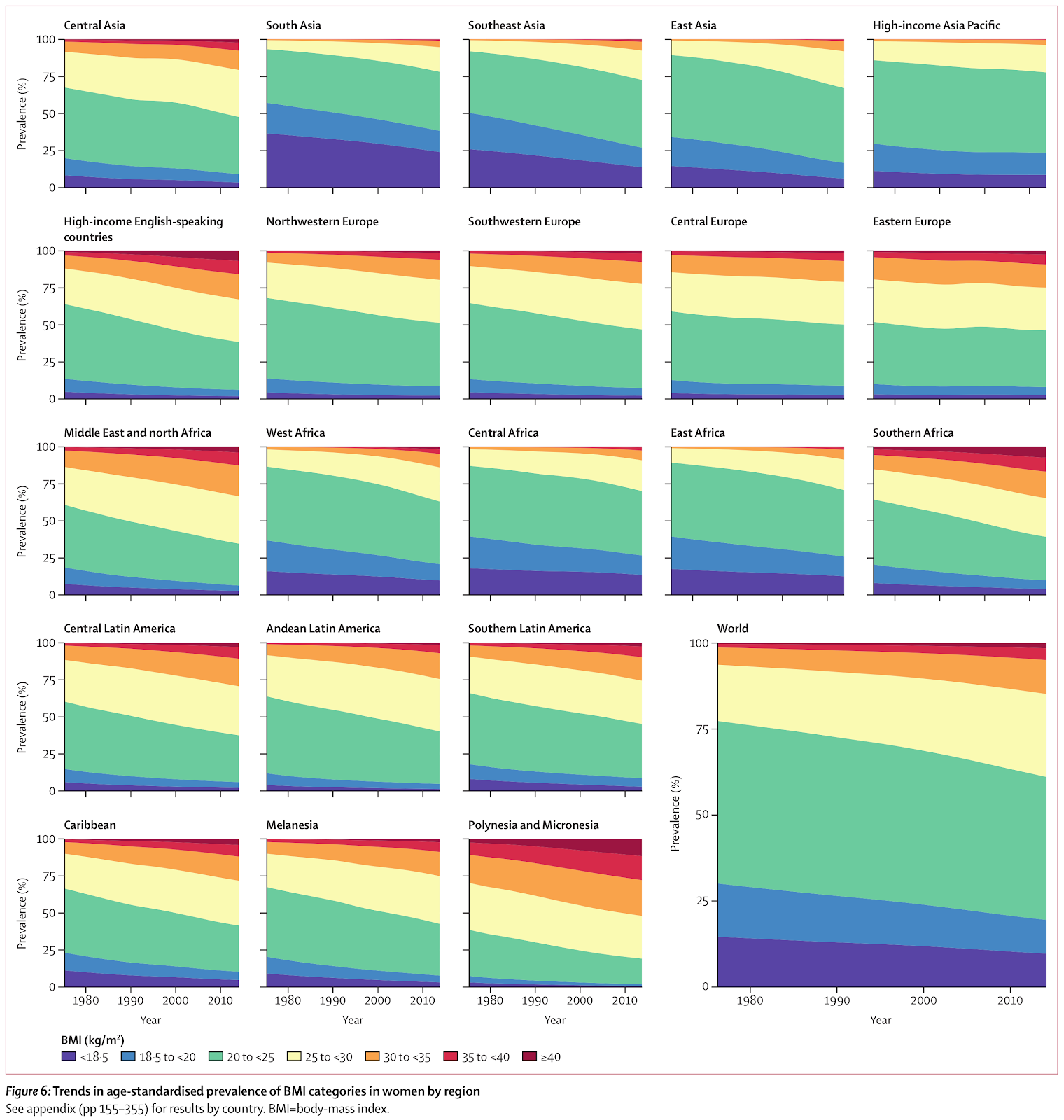
Underweight people are too rare in high-income countries for any trend to be easily discernable from that figure, so let us zoom in on US data. In the US, the prevalence of underweight among adults aged 20-74 hasdecreased almost monotonically (a) over the past several decades:

Likewise, data from the United Kingdom showa consistent decrease (a) in the prevalence of underweight among adults from 2000 to 2016:

It is true that, as the SMTM authors point out, the variance in BMI has increased, butthat is entirely due to higher BMIs being more common (at least in the countries for which I have data, which are the UK and the US). Here is how the distribution of BMI has changed from the first NHANES (in the early 70s (orange)) to the last one (from 2017 to 2020, in blue)[5]:
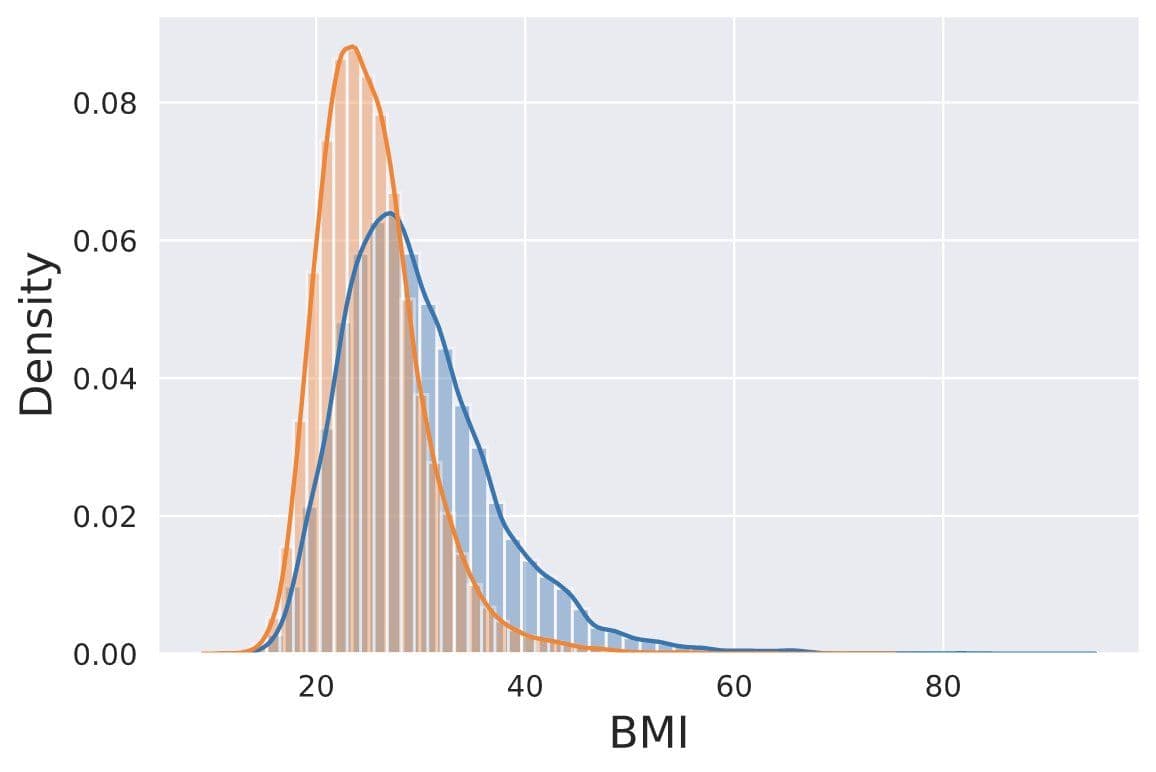
The code used to make this plot ishere.
And here are BMI distributions from the UK in 1993 and 2018, fromthe UK Health Security Agency (a):

The altitude effect
When you look at county-level or state-level US obesity data, itsvery clear (a) that altitude is (negatively) associated with obesity. Notably, the association remains after controlling for several relevant variables, as shown inVoss et al. (2013). And we have evidence that the effect is causal:Voss et al. (2014) found that members of the US Army or Air Force were less likely to become obese if they were assigned to live in a high-altitude county. Moreover, it is well-established in the literature that ascending to high altitudes causes weight loss in the short term.
So why is this a thing?
A good starting point is to see whatthe 2016 Slate Star Codex post about the phenomenon (a) has to say about its cause:
The active ingredient of altitude seems to be hypoxia. The air is thin at high altitudes so the body gets less oxygen. Being in low oxygen conditions in normal pressure seems to cause weight loss too see here and here for studies of people exercising in low oxygen conditions. I dont know of any studies where people were just kept in low-oxygen environments for a long time without exercise to see what happened to their weight. Its not really clear how reduced oxygen makes people eat less.
The SMTM authors disagree, claiming that the effect of altitude on obesity cannot be explained by anything about the atmosphere. What is their argument, you ask? Well,this is it (a):
We know that oxygen and carbon dioxide vary with elevation, so you might expect that this is attributable to these differences. But the evidence is pretty thin. Combined with a low-calorie diet, exercise in a low-oxygen environment does seem to reduce weight more than exercise in normal atmospheric conditions, but not by much. Submarines have CO2 levels about 10 times higher than usual, but a US Navy study didnt find evidence of consistent weight gain. The atmosphere itself cant explain this.
I dont think this does a good job at all of addressing the evidence for the role of the atmosphere. The participants in the low-oxygen study they cited spent only 3.6% of their time (6 hours per week) in hypoxia, for only four weeks. That is clearly different from spendingall of your time for decades in a hypoxic environment, as people who live in high altitudes do. Also, its unclear why they imply that the effect wasnt large: the study they cited said that the hypoxia group lost 2.6 kg (5.7 lb) more than the control group over 4 weeks.
Moreover, that study only changed the oxygen content of the air subjects were breathing. It exposed them to what is called normobaric hypoxia in the research literature. Normobaric means that the ambient air pressure was unchanged. People who live in high altitudes are subject tohypobaric hypoxia instead, whichseems to cause more severe effects than normobaric hypoxia for the same oxygen levels.
So I dont think theyve presented enough evidence in that paragraph to completely rule out the idea that the atmosphere is responsible for the altitude effect.[6]
Neither the 2016 SSC blog post nor the SMTM authors ever mention the studies that seem most relevant for figuring out whether hypobaric hypoxia is responsible for the altitude effect: the ones that confine people to hypobaric chambers continuously for weeks.
Hypobaric confinement seems to cause a lot of weight loss: the three Operations Everest and other studies
When researching experimental hypobaric confinement for this blog post, I came across some of the most dangerous studies on healthy humans Ive ever heard of: the three Operations Everest.
As the title of this section suggests, those three studies involved putting people inside hypobaric chambers, and, as the study names suggest, those chambers eventually reached an air pressure close to that of the summit of Mount Everest. So lets take a look at those studies.
Operation Everest I (conducted in 1946 by the US Navy):
4 healthy young men were selected [...]. They lived in a decompression chamber [...] for 32 days during which the chamber was gradually decompressed to a simulated altitude of 22,000 ft [6,705.6 m] (350 torr) where they remained for 4 days.
[...]
Appetites declined and all subjects lost weight (average 6 pounds in the last 2 weeks).
Unfortunately, I could find no further information about body weight changes.
Operation Everest II (conducted in 1985, also by the US Navy):
[S]ix men, provided with a palatable ad libitum diet, were studied during progressive decompression to 240 Torr [equivalent to 8,848 m] over 40 days in a hypobaric chamber where hypoxia was the major environmental variable. Caloric intake decreased 43.0% from 3,136 to 1,789 kcal/day (P < 0.001). [...] Over the 40 days of the study the subjects lost 7.4 2.2 (SD) kg [16.28 4.8 lb] and 1.6% (2.5 kg) of the total body weight as fat. Computerized tomographic scans indicated that most of the weight loss was derived from fat-free weight.

This corresponded to 8.9 2.0% (mean SD) of participants starting body weight.Operation Everest III:
Energy and water balance was studied over 31 days in a hypobaric chamber at 452253 Torr (corresponding to 4,5008,848 m altitude), after 7 days acclimatization at 4,350 m. Subjects were eight men, age 274 years (meanSD), body mass index 22.91.5 kg/m2.
[...]
Body mass changed throughout the experiment. The changes from normoxia to day 2, over days 217 and over days 1731 were 1.40.8 (P<0.01), 2.51.1 (P<0.001) and 1.20.6 kg (P<0.01), respectively
I calculated that, as a proportion of starting body weight, the weight loss was 6.9 2.1% in this study.
There have been shorter and less extreme hypobaric hypoxia studies.
Greenleaf et al. (1987) found that participants lost on average about 1% of their body weight after 8 days at a simulated altitude of 2,287 m. Interestingly, this is around the same average % weight loss as that found inLippl et al. (2010), a real-altitude study that took people to an altitude with a similar barometric pressure (2,650 m) for a similar period of time (7 days).
Gatterer et al. (2021) confined 12 young women to a hypobaric chamber twice, once with the chamber turned on at a pressure of 493 mmHg (equivalent to 3,500 m) and once with it turned off. The women, who at the start of the experiment weighed an average of 60.6 kg (133.3 lb), lost on average 0.71 kg (1.56 lb) in four days during the hypobaric hypoxia period, while their weight remained stable during the control period.
Buchzik et al. (2014) is a double-blind, placebo-controlled, reverse simulated altitude study. It took all subjects to a high altitude (2,760 m) for seven days, but gave supplemental oxygen to the control group. I cant find the full text, but the abstract says that the intervention group weighed significantly less than the control group who gained weight at D14 i.e. after the high-altitude stay.
Those were all of the studies of hypobaric hypoxia confinement in humans Ive found that reported changes in body weight.
Normobaric hypoxic confinement, too, seems to cause weight loss, in both humans and animals
Humans
Studies of normobaric hypoxic confinement in humans likewise find a trend towards weight loss, though none of those studies have been as extreme as the Operations Everest, as far as I can tell.
Mekjavic et al. (2021) confined 8 obese men to both a hypoxic chamber and a normoxic (normal-oxygen) chamber in a crossover manner. During hypoxic confinement, they lost on average 0.7 0.2 kg, and during normoxic confinement, they gained 1.0 0.2 kg.
Mekjavic et al. (2016) found 0.2 kg greater weight loss in hypoxic confinement than in normoxic confinement after 10 days among a group of 11 thin men. Mean daily energy intake was substantially lower in hypoxia (2472 251 kcal) than in normoxia (2847 241 kcal).
Debevec et al. (2014a) measured body weight changes in 11 healthy men after three 21-day interventions: bed rest, hypoxia and bed rest with hypoxia. The men lost 1% and 2% more of their body weight on the hypoxic and hypoxic bed rest interventions, respectively, than on the normoxic bed rest intervention.
Debevec et al. (2014b) confined 14 healthy male participants to a normobaric hypoxic chamber for 10 days, and randomized them to either exercise or not. Both groups lost weight, by an average of 1.4 kg.
Those were all of the studies of normobaric hypoxia confinement in humans Ive found that reported changes in body weight.
Animals
J. Argyll Campbell was a late 19th-century and early 20th-century scientist who was academically interested in the physiological effects of hypoxia. He conducted dozens of studies in which he confined animals to low-oxygen environments for several weeks or months. As far as I could tell, in all of them[7], the poor animals rapidly lost a lot of weight, and many of those were young and supposed to be growing. Here is a sample chart from one of his papers,Campbell (1934) (a), showing that young mice in hypoxic environments completely fail to grow up (the arrow labeled 21 denotes when the mice in the experimental condition returned to an environment with the normal partial pressure of oxygen at sea-level, which is ~21% of astandard atmosphere):
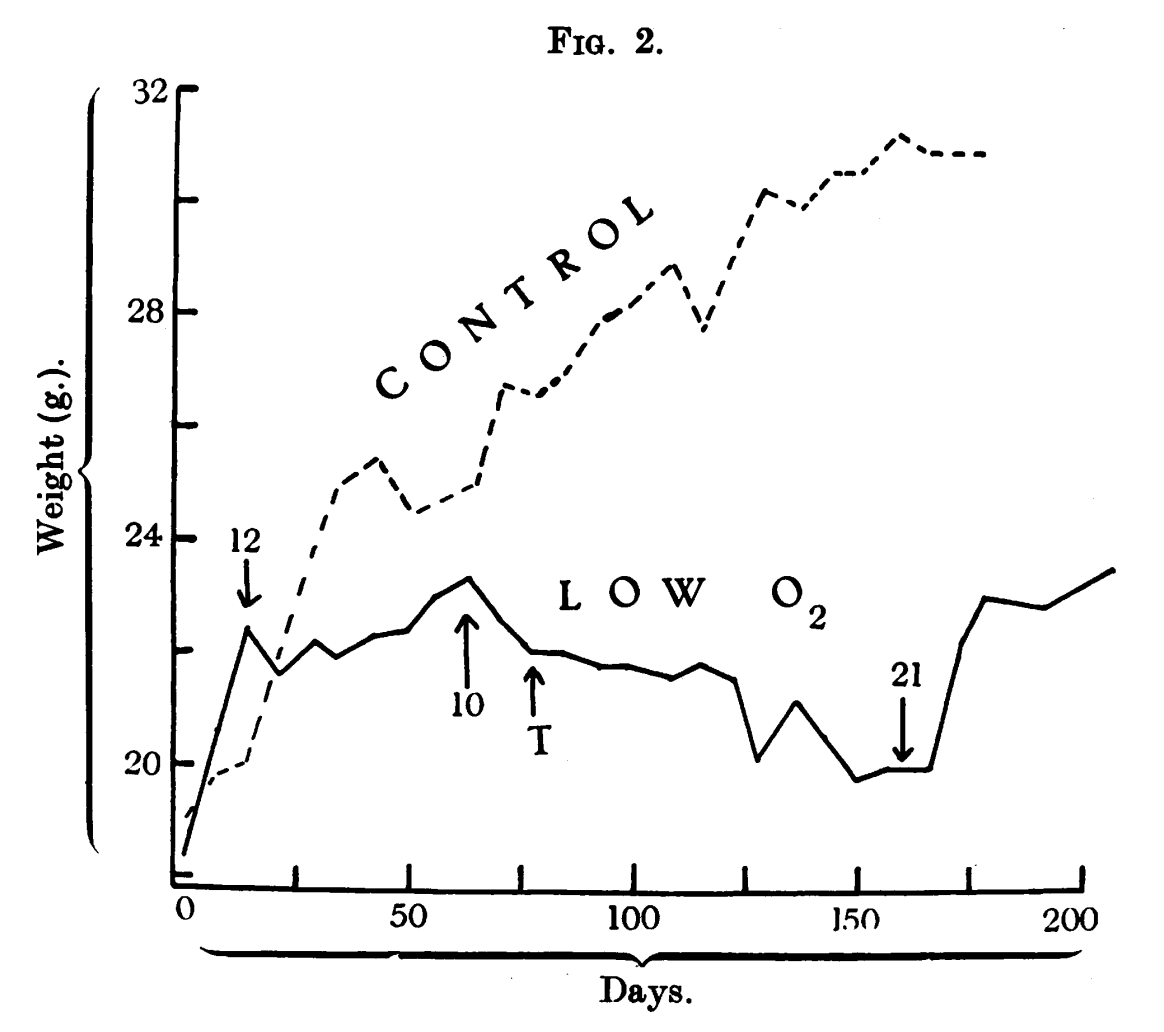
Food is apparently less appetizing in hypobaric conditions
Apparently, airlines have found that odor and taste perceptions get worse inside airplanes at cruising altitude (whose cabin pressures correspond to an altitude of ~6,000 ft to ~8,000 [~2,000 m to ~2,500 m] according to a quick Google search). Seethis Business Insider article andthis BBC article. The articles mentionthis study, which found that odor and taste perception get worse insidesimulated aircraft cabins, i.e. hypobaric chambers with a bit more noise and air dryness.
Relatedly,Matu et al. (2018), a systematic review and meta-analysis on the effect of hypoxia on hunger perceptions, found thatactual high altitude in general doesnt seem to affect hunger-related variables more than simulated altitude does (see their subgroup analysis on Table 1), though there were a small number of studies involved. In fact, studies that simulate high altitude with hypobaria (as opposed to normobaric hypoxia) seem to showgreater effects on hunger perception than studies that actually take people to high altitudes.
The dose-response relationship between altitude and body weight seems incompatible with the contamination hypothesis
Most industrial water contamination in the US probably happens at relatively low altitudes, since thats where most people live. A very small fraction of the US population lives more than 1,000 m (3,280.84 ft) above sea level:

The x-axis is in meters.
So, if the altitude effect were entirely caused by contaminants, we would expect moving from 0 m to 1,000 m to have a much greater effect on body weight than moving from 2,000 m (6,561.68 ft) to 3,000 m (9,842.52 ft) in the US.
But the information we have about this topic seems to suggest that the opposite is true.Voss et al. (2013) found that the altitude effectaccelerates with increasing altitude. The prevalence of obesity is barely different at 1,000 m than at 0 m across United States counties, and then there is a sharp drop-off from 2,000 m upwards:

Likewise,Voss et al. (2014) found that US military members assigned to high-altitude locations (>1,960 m) had a 41% (95% CI 35%-46%) lower chance of becoming obese than those assigned to low-altitude locations (<980 m), but that those assigned to medium-altitude locations (980 m-1,960 m) only had a 5% (95% CI 0%-10%) lower chance of becoming obese.
Moreover, by the same logic, the contamination theory would predict that, at altitude ranges with very little or no industrial contamination, altitude should stop affecting body weight altogether. If you are on a mountaineering expedition, why should being at, say, 6,000 m rather than 4,000 m make any difference to your body weight? There is barely any industrial activity above 4,000 m, as far as I am aware, and exactly zero of it in most mountains people climb. And yet, as far as I can tell, exposure to extreme altitudes seems to cause more weight loss than exposure to very high but lower altitudes.
Demographic factors and altitude could adequately explain the geospatial distribution of obesity in the US
The distribution of obesity across US stateslooks something like this:

(Im using state-level instead of county-level data because county-level obesity datasetsdont correlate well with each other.)
Heres a choropleth I created myself, using the same data as the one above but on a continuous color scale:
As Ive mentioned before, you can see that altitude seems to be negatively associated with obesity.
But it does not seem to be the only obvious factor at play after all, states like West Virginia (high-ish average altitude) are a lot more obese than states like Massachusetts (low average altitude). I did a simple linear regression and found that population-weighted average altitude explains about 7% of the variation in obesity rates across US states, leaving a lot unexplained.
The SMTM authorsclaim (a) that that is because of environmental contaminants:
Its important to note that altitude itself doesnt affect obesity directly. Instead, altitude is a proxy for how high an area is in the watershed, which is itself a proxy for how badly the local water supply is contaminated. This is why Mississippi is more obese than low-lying areas of California. In California the water supply hasnt traveled nearly as far in its path to the ocean, and has traveled past fewer farms, highways, cities, and factories.
But there are very important differences between high- and low-obesity states that I think must be taken into account.
Foreign-born population
US states vary widely in the proportion of their population that is foreign-born. The differences are really not subtle.In California, 1 in 3.7 people was born outside of the United States, compared to 1 in 67 in West Virginia (a).
You can see that the highest-obesity states tend to have fewer foreign-born people as a proportion of their population:
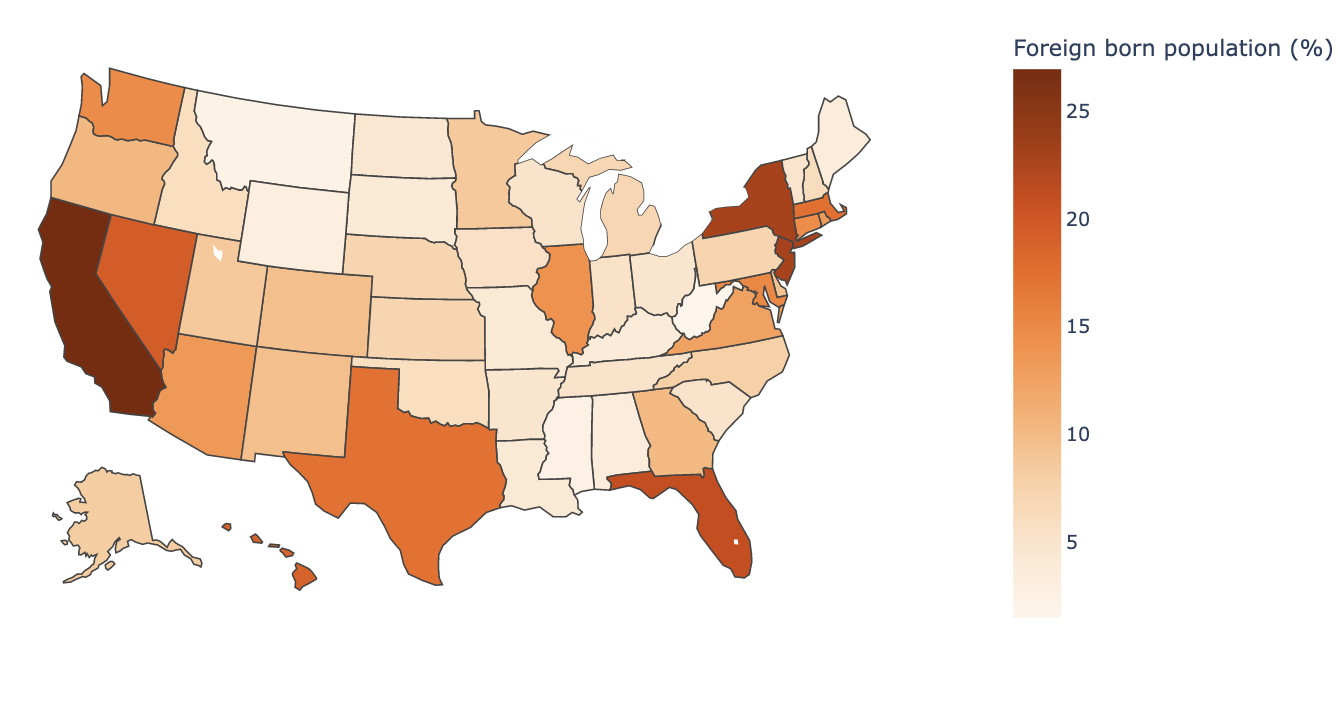


A multiple linear regression model with population-weighted average altitude and proportion of the population that is foreign-born as independent variables explains 45.5% of the variation in obesity rates across US states, so this is a way better model than altitude alone.
This makes sense becausemost countries have a lower obesity rate than the US (a). And although immigrants to the US do gain weight with time, theyremain leaner than the native population for more than a decade after arrival.
The SMTM authors havent addressed the possibility that immigration could play a role in explaining the obesity rate differences between US states. Theyve writtena post (a) claiming that those differences cannot be explained by demographic factors, but dont mention immigration anywhere in it.
Race and ethnicity
There are racial and ethnic disparities in the prevalence of obesity in the United States (seethis page on the CDC website (a) for more information). Accordingly, a linear regression model with % (non-Hispanic) Asian, % (non-Hispanic) Black and % Hispanic variables (chosen because those are the three largest racial/ethnic minority groups) on top of the variables weve discussed above (population-weighted average altitude and proportion of the population that is foreign-born) explains 74% of the variation in state obesity rates.
Education
It turns out that education is strongly negatively associated with obesity across US states:

I usedthis obesity dataset from the CDC andthis educational attainment dataset from the USDA to create this chart.
Heres the data in choropleth form:


A Chemical Hunger talks a lot about how Colorado (the #1 leanest state) is a lot less obese than any other US state, and how that is probably explained by its high average altitude and thus low exposure to environmental contaminants in water. But one thing the SMTM authors never mention about the state is that it is suspiciously #2 in the nation in its proportion of adults with college degrees, behind only Massachusetts (which also happens to be the #2 leanest state).
At the individual level, the obesity rate of adults without a college degree in the USis around 40%, compared to about 28% for those with a degree though earlier educational milestones (e.g. completing high school, or attending college but not graduating) dont have a consistent association with obesity.
Adding education to our linear regression model takes theR2from 0.74 to 0.82.
| Independent variables | R2 | adjusted R2 | Leave-one-out negative mean absolute error |
| Population-weighted average altitude | 0.07 | 0.05 | -3.3 |
| Population-weighted average altitude + % foreign-born | 0.455 | 0.407 | -2.9 |
| Population-weighted average altitude + % foreign-born + % Asian + % Black + % Hispanic | 0.74 | 0.71 | -2.1 |
| Population-weighted average altitude + % foreign-born + % Asian + % Black + % Hispanic + % with college degree | 0.82 | 0.79 | -1.9 |
(Codehere.)
Anyway. It is definitelyplausible that environmental contaminants are responsible for the geographical disparities in obesity rates in the US. But I dont see any indication that environmental contaminants arenecessary to explain them, as the SMTM authors claim they are.
High-obesity states do poorly on a lot of different health metrics, not just obesity
Consider the following scatterplots:
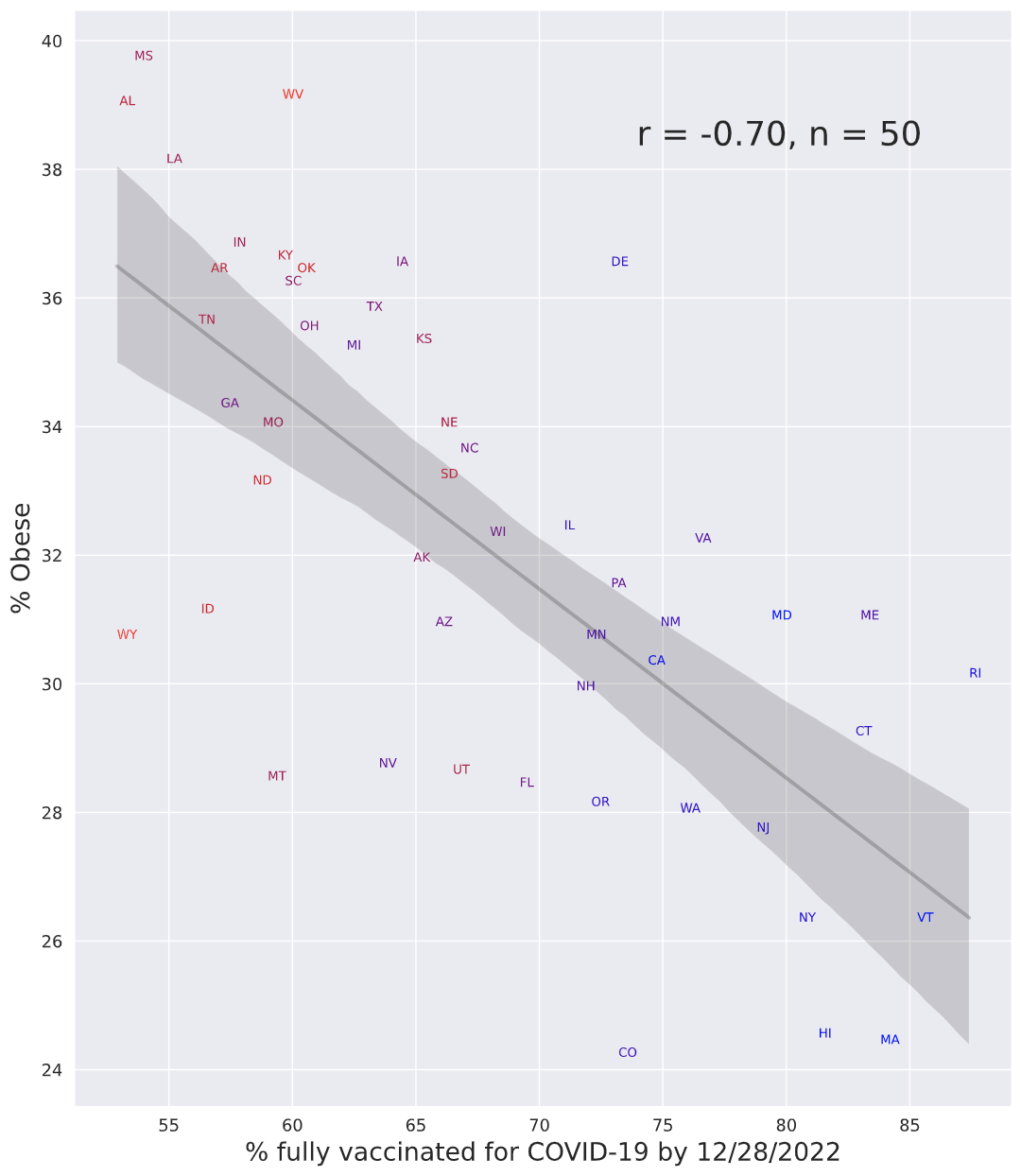


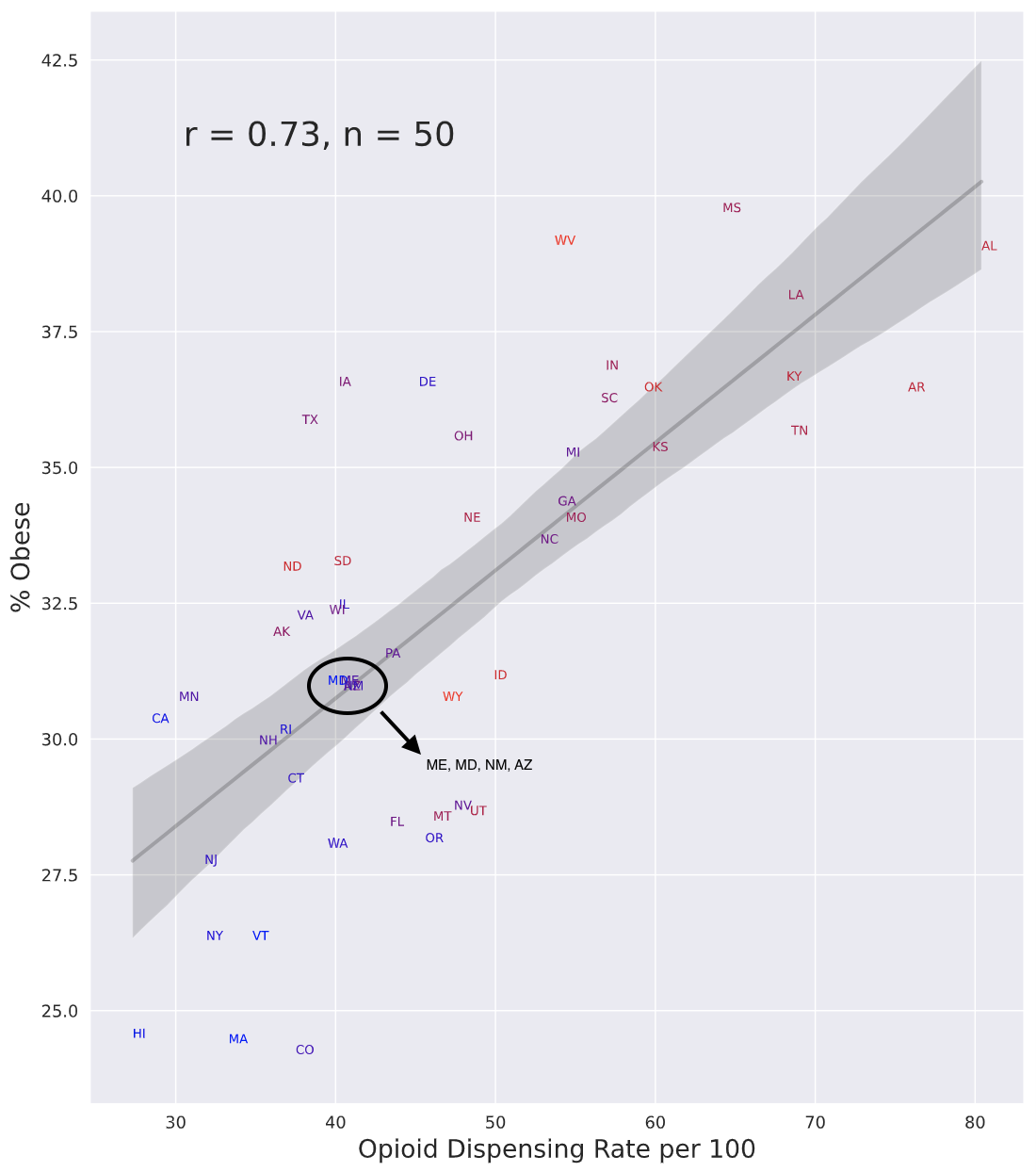
(States are colored according to the Democratic vote margin in the 2020 general presidential election. My code is inthis Colab notebook.)
Racial and ethnic minorities face unique challenges in accessing healthcare, so we should control for race and ethnicity. Doing so, this is what we get:
| Variable | Partial correlation with obesity rate, controlling for race and ethnicity |
|---|---|
| COVID-19 vaccination rate | -0.59, 95% CI [-0.75, -0.36], p = 0.000013 |
| Opioid dispensing rate | 0.52, 95% CI [0.27, 0.7], p = 0.000177 |
| Democratic vote margin in 2020 | -0.62, 95% CI [-0.77, -0.41], p = 0.000003 |
| Permanent tooth removal rate | 0.40, 95% CI [0.13, 0.62], p = 0.004976 |
| Smoking rate | 0.60, 95% CI [0.38, 0.76], p = 0.000007 |
| Percentage of adults with a Bachelors degree or higher | -0.69, 95% CI [-0.82, -0.5], p = 8.220840e-08 |
It just seems that theres a group of states that do poorly ona lotof health metrics. They have higher rates of smoking, permanent tooth removal, and opioid dispensing, along with lower rates of COVID-19 vaccination,and they have higher obesity rates. Also, this seems really quite strongly related to partisanship for some reason.
This seems to be a classic case of a lot of variables being correlated with each other, with the underlying cause being difficult to disentangle. I dont see any indication that environmental contaminants rather than more pedestrian things like differences in cultural or socioeconomic factors must be the underlying cause.
Contaminants are not needed to explain the obesogenic effects of palatable human food
One intuitive explanation of the obesity epidemic is that it is caused by exposure to ultra-processed/hyper-palatable/cafeteria diet-like human food. And, perhaps unexpectedly to a lot of people, the SMTM authors acknowledge(a) the obesogenic properties of that type of food:
Mystery 6: Palatable Human Food
Lab rats gain some weight on high-fat diets, but they gain much more weight on a cafeteria diet of human foods like Froot Loops [sic] and salami (see also here).
[...]
Rodents eating diets that are only high in fat or only high in carbohydrates dont gain nearly as much weight as rodents eating the cafeteria diet. And this isnt limited to lab rats. Raccoons and monkeys quickly grow fat on human food as well.
We see a similar pattern of results in humans. With access to lots of calorie-dense, tasty foods, people reliably overeat and rapidly gain weight. But again, its not just the contents. For some reason, eating more fat or sugar by itself isnt as fattening as the cafeteria diet. Why is palatable human food so much worse for your waistline than its fat and sugar alone would suggest?
The SMTM authors think this happens because processed food has more contaminants:
Lab rats gain more weight from human foods than they do from rat chow with similar nutritional properties because obesity doesnt come from fat or carbohydrate content, but from contaminants in the food, and human food has more contaminants than the rat chow does, likely from packaging and processing.
But there is an alternative hypothesis in the academic world,explained in Stephan Guyenets The Hungry Brain, and summarized in Scott Alexanders review of the book. The TL;DR is that the rewarding qualities of modern human food damage your brains weight-regulation mechanism. It makes sense to be skeptical of this explanation if you believe that lab or wild animals are getting fatter, or that contaminants are needed to explain geospatial discrepancies in obesity rates. But, as I explained in earlier sections of this post, neither of those two things is clear, which makes this explanation more plausible than it would otherwise be.
On Some Conceptions Of CICO
Disclaimer
CICO is an extremely touchy subject, and in this section I will criticize SMTMs criticisms of CICO. So, before I do that, Id like to make a few things clear:
- Most popular conceptions of CICO do not describe a law of physics. For example, if you interpret CICO as meaning that weight changes are purely a function of calories consumed minus calories burned, that is wrong because it doesnt take into account that your body can get rid of calories without necessarily burning them. People with untreated diabetes mellitus pee out a lot of sugar, and the calories in the sugar they pee out are obviously neither burned nor stored as energy in their bodies. For more examples of things like this, see the comments inthis Facebook post by Spencer Greenberg. See alsoEliezer Yudkowsky on this topic.
- Obesity is not caused by a lack of willpower. Your brain has a lipostat that employs an array of different mechanisms for keeping body fat at a certain level. It is so sophisticated that even exercising moreoften just results in your body burning less energy in maintenance and repair (a) to compensate (yes, seriously). Some particularly unsophisticated conceptions of CICO that are not taken seriously in the research world do not take this into account, and they are wrong.
- Even smart conceptions of CICO that take the points above into account have limited usefulness in explaining the obesity epidemic. They leave open the question ofwhy people are consuming more calories (or burning/wasting fewer calories) than they were several decades ago.
With that out of the way, I'll explain why I think SMTM's arguments against CICO were weak.
Overeating for weeks != overeating for decades
The SMTM authors say that overfeeding studies are evidence against CICObecause people dont gain that much weight in them (a):
Overfeeding in controlled environments does make people gain weight. But they dont gain enough weight to explain the obesity epidemic. If you eat 10,000 calories per day, you might be able to gain 20 or 30 pounds, but most Americans arent eating 10,000 calories per day.
We can compare these numbers to the increases in average calories per day we reviewed earlier. Sure, consumption in the US went from 2,025 calories per day in 1970 to 2,481 calories per day in 2010, a dierence of 456 calories. But considerPoehlman et al. (1986), where researchers fed a group of 12 men 1,000 extra calories a day for 22 days. On average the men gained about 5 lbs (2.2 kg), but some of them actually lost weight instead.
I think this is flawed. Clearly, overeating for your entire life will probably have different effects from overeating for 22 days. There are a lot of 22-day periods in a persons life. Someone on their 30th birthday has gone through nearly 500 of them.
If you try to make an educated guess on whether 456 extra kcal/day is enough to explain the change in average body weight, instead of assuming that 22 days of overeating will have the same effects as 3 decades of overeating and considering the question closed, you not only find that the 456 kcal number is enough, but you find that it isway too high which just renders SMTMs point all the more bizarre. Let me explain.
How much body weight can you expect to gain if you start eating 456 extra kcal per day? Some people bring up the 3,500 kcal = 1 lb rule of thumb and predict youd gain 47.6 lb per year, or... a comical 1,428 lb by age 30. But that isnot a good model, because eventually your energy expenditure will catch up with your increased energy intake. So what would a better model say?
Fortunately, Kevin Hall hasa paper explaining a much better model, anda web-based tool implementing it. The rule of thumb the paper provides is that having 10 extra kcal/day leads to a 1 lb (0.45 kg) change in body weight in the long-term, with 95% of the change occurring in about 3 years. This means that a 456 kcal/increase in energy intake will eventually lead to a 45.6 lb increase in body weight.
In comparison, according tomy analysis of NHANES data, the average American adult gained 12 kg (~26.4 lb) since the early 70s, way less than the 456 kcal number predicts. So yes, a 456 kcal increase in average daily energy intake wouldabsolutely be a jaw-dropping increase.
Of note, this 456 kcal number is based on self-report data, so its not likely to be that accurate. Stephan Guyenet mentions a better estimate onThe Hungry Brain based on food disappearance data from the USDA, which is only 218 kcal/day, much more consistent with Kevin Halls model.
Equivocating between different meanings of the word overeat is not a good argument
FromA Chemical Hunger Interlude A: CICO Killer, Quest-Ce Que Cest? (a):
One way to interpret CICO (or one sub-hypothesis) is that it claims there is a strictly linear relationship between calories eaten/burned and weight change. This is specified if we take weight gain = calories in calories out literally. Essentially, this hypothesis says that overeating by the same amount should always lead to the same amount of weight gain.
This is clearly false. The overfeeding studies provide extremely strong evidence against this version of CICO, since people gain very different amounts when overfed by the same amount, the difference appears to be mostly genetic, and some people actually lose weight, even when overfed by moderate (1000 kcal/day) amounts. Many people still believe something like for every extra 3500 calories you eat you always gain one pound, but all available evidence comes down very strongly against that.
Notice the equivocation here. Does overeating by X calories mean eating X calories more than you usually do or eating X calories more than youreactually burning throughout the study? Overfeeding studies do not provide extremely strong evidence against the version of CICO the SMTM authors described unless they make people overeat by the same amount in thesecond sense of the word overeat.
And, from my review of overfeeding studies,that does not seem to be at all what theyre doing. They usually just give everybody a fixed absolute (e.g. 1000 kcal) or relative (e.g. 20%) energy surplus, with the relative surplus being calculated from your normal caloric consumption. They dont constantly readjust the number of calories youre eating each day based on how many calories you burned the previous day.
Accordingly, as explained in aThe Hungry Brain quote cited in a2017 SlateStarCodex post (a), the primary reason there is variation in weight gain in controlled feeding studies seems to be that some people ramp up their energy expenditure a lot more than others, which is perfectly consistent with CICO:
The research of James Levine, an endocrinologist who works with the Mayo Clinic and Arizona State University, explains this puzzling phenomenon. In a carefully controlled overfeeding study, his team showed that the primary reason some people readily burn off excess calories is that they ramp up a form of calorie-burning called non-exercise activity thermogenesis (NEAT). NEAT is basically a fancy term for fidgeting. When certain people overeat, their brains boost calorie expenditure by making them fidget, change posture frequently, and make other small movements throughout the day. Its an involuntary process, and Levines data show that it can incinerate nearly 700 calories per day.
CICO is compatible with body weight regulation
From a section inCurrent Theories of Obesity are Inadequate (a) addressing CICO:
A popular theory of obesity is that its simply a question of calories in versus calories out (CICO). You eat a certain number of calories every day, and you expend some number of calories based on your metabolic needs and physical activity. If you eat more calories than you expend, you store the excess as fat and gain weight, and if you expend more than you eat, you burn fat and lose weight.
This perspective assumes that the body stores every extra calorie you eat as body fat, and that it doesnt have any tools for using more or less energy as the need arises. But this isnt the case. Your body has the ability to regulate things like its temperature, and it has similar tools to regulate body fatness. When we look closely, it turns out that calories in, calories out doesnt match the actual facts of consumption and weight gain.
But CICO does not imply that your brain cant regulate your body weight. It just says that if your brain wants to keep you thin, but you overeat, your brain will have to make you burn (or waste) extra calories. And, as weve seen before, that is indeed how some people manage to stay thin in overeating studies.
In fact, Stephan Guyenet who the authorsare well acquainted with wrote an entire book about how the brain regulates fat adiposity, which, as expected, by no means contradicts CICO. So its puzzling to me that SMTM would put forward that kind of argument. I think they should have made it clear that they were arguing against particularly weak conceptions of CICO.
Under the CICO model, a lot of things are allowed to influence body weight
As I explained in the section above, CICO is merely a theory about what kinds of things go along with weight gain and loss. It doesnt say anything aboutwhat is ultimately causing weight change. So it is perfectly compatible with things like altitude affecting body weight.
As an analogy, consider the theory that the mechanism underlyingmultiple sclerosis (MS) is the attack and destruction of myelin sheaths by the immune system. Is this theory incompatible with the fact that MS prevalence seems strongly related to latitude, much like obesity is strongly related to altitude? Or with the fact that MS is a lot more common in women than men, and for some reason almost always starts in youth or middle age? Or with the fact that MSseems to essentially be long mono? Or with the fact that MS is slightly heritable? Of course not. If you dont have a reason to believe that immune system dysfunction shouldnt be affected by age, gender, latitude, past EBV infection, or genetics, those things are zero evidence against the theory.
On the other hand, if you actually had a lot of trustworthy studies showing that the immune system is no more likely to destruct myelin sheaths among people far from the equator who are more likely to get MS than among people close to it, then that theory would be in some trouble.
Notably, this means that CICO is perfectly compatible with SMTMs contamination theory of obesity, to the extent that we dont believe that its impossible for environmental exposure to chemicals to affect caloric intake or expenditure. I think it would have made more sense for SMTM to try to take down the hyperpalatability theory of obesity instead of CICO, but they notably dont talk much about the theory in their series.[8]They even agree that eating palatable, processed human food causes overeating and weight gain, as I mentioned earlier.
Conclusion
As I said at the beginning of this post, the contamination theory of the obesity epidemic is plausible a priori. But that remains the strongest argument in favor of it that Ive found, in my opinion. As far as I can tell, we dont have evidence that wild animals have become more obese over time, or that people lose weight by drinking distilled water. People in rural areas in the US are more likely to be obese than those living in cities, not less, even though it seems plausible that theyre exposed to less industrial contamination. And we dont need contaminants to explain the effect of altitude on body weight, or other geospatial patterns in the prevalence of obesity.
In light of all of this, Im comfortable being the largest NO shareholder in this play-money prediction market:
However, I think it would be interesting to see more discussion on the contamination theory of the obesity epidemic, and Im open to changing my mind. So let me know in the comments if you find compelling evidence in favor of it that Ive missed.
Acknowledgments
Thanks to Jos Luis Ricn Fernndez de la Puente, ChatGPT, and my husband Matthew Barnett for helpful comments and suggestions in earlier drafts of this post.
I do not speak for anyone other than myself, and all errors are my own.
Addenda
SMTMs posts still have factual inaccuracies and misrepresentations of sources
In my last blog post, published over six months ago, Ilisted several factual inaccuracies and misrepresentations of sources in SMTMs blog posts about lithium. I and others have tried to contact the SMTM authors about those issues several times, both before and after that post was published, but they have never corrected any of them, and Manifold Markets doesnt think theyll correct them by June 2023.
I think that making mistakes every once in a while is obviously fine, but that people should correct incorrect information theyve published if theyre shown its incorrect. It is concerning to me that the SMTM authors have chosen not to do so.
(Non-exhaustive) errata/changelog
The first version of this blog post argued that, contra the SMTM authors, there wasn't an abrupt shift in obesity rates in the late 20th century. Further discussion in the comments made me realize that the argument I was trying to make was too semantic in nature and exaggerated the differences in our perspectives. I changed this about 8 hours after the post was published.
The first versions of this post described John Komlos and Marek Brabec as "economists." I changed this after realizing that Marek Brabec is a statistician and John Komlos is an economic historian. Sorry!
- ^
The SMTM authors have not replied to or acknowledged the existence of that post. The closest theyve gotten to doing so was a post they wrote addressing 5 of the ~17 studies I mentioned that found low concentrations of lithium in food and claiming that they are outliers in the literature, a claim that they supported by misrepresenting their sources, as I explainhere.
That post they wrote seems to indicate that they had not yet actually read my post, as they say that those 5 studies "disagree with basically every other measurement [they]ve ever seen for lithium in food" (and repeat this point quite a few times), so it seems more likely that they were attempting to reply to an earlier Twitter thread of mine that mentioned only those 5 studies rather than to my post itself. Their post also doesn't acknowledge or mention any of the other points I made in my post.
- ^
I am aware of one other substrain of C57BL/6 mice: C57BL/6N,bred (a) in the National Institutes of Health. This seems to be substantially less commonly used in research than C57BL/6J Google Scholar returns 395,000 results for C57BL/6J and only 32,000 for C57BL/6N. Likewise,this slide deck (a) says that More than 90% of the worlds published references to C57BL/6 sub-strains refer to the C57BL/6J substrain, which originates from The Jackson Laboratory.
- ^
- ^
This (a) is the post in which they cited the article. Quoting from it:
Everyone knows that the average BMI has been going up for decades, but what is less commonly known is that the variance of BMI hasalso increased since 1975. When expressed in standard deviation, it has almost doubled in many countries. As correctly notedin The Lancet, this contributed to an increase in the prevalence of people at either or both extremes of BMI.
I dont know exactly what theThe Lancet article meant by that quote, but they definitely did not mean that the prevalence of underweight has increased over time, since they actually show that it has decreased.
- ^
The data in this figure is generated with weighted kernel density estimation (using the default parameters ofsklearn.neighbors.KernelDensity). This is necessary because NHANES oversamples some groups, so every time you want to do any kind of analysis with NHANES data you have to weigh each sample by its sampling weight. However, in case you were wondering, the underlying raw datalooks similar:
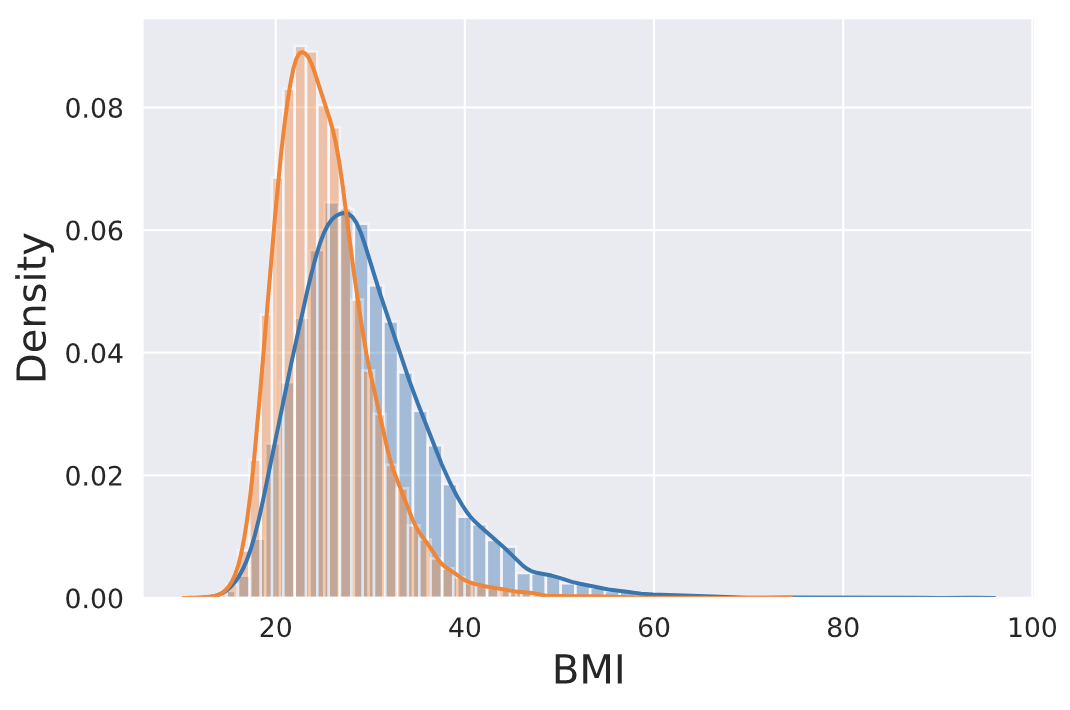
- ^
The SMTM authorsdid publisha lengthy critique (a) of a particular study on the effects of altitude on body weight (Lippl et al. (2010)), and their post was somehowadvertised on Astral Codex Ten (a) as a critique of the research on hypobaric hypoxia causing weight loss, (and the SMTM authors painted as such). But that is an extremely misleading description the SMTM authors criticize a single study, not the research on hypobaric hypoxia causing weight loss, and they dont even mention or addressany of the studies on the effect of simulated high altitude in hypobaric chambers at all (neither in that post nor anywhere else in their blog or social media).The study they criticized just took people to a high altitude for seven days and observed that they lost weight. It seems that SMTMs criticism is that it had a weird statistical methodology?
- ^
To make sure that I wasnt missing any relevant studies from him, I searched on PubMed forCampbell JA[Author] and (oxygen[Title/Abstract] or altitude[Title/Abstract]), and looked through the citations of each relevant article to find any that might be missing from that search.These ended up being all the relevant articles from him that I have found and read:Campbell J. A. (1927). Further observations on oxygen acclimatisation. The Journal of physiology, 63(4), 325342.https://doi.org/10.1113/jphysiol.1927.sp002407Campbell J. A. (1930). Living at very high altitudes and maintenance of normal health. The Lancet, Volume 215, Issue 5555, 370-373.https://doi.org/10.1016/S0140-6736(00)88121-0Campbell J. A. (1935). Further Evidence that Mammals Cannot Acclimatize to 10 p.c. Oxygen or 20,000 feet Altitude. British Journal of Experimental Pathology, 16(1), 3948.https://www.ncbi.nlm.nih.gov/pmc/articles/PMC2065096/ (a)
- ^

